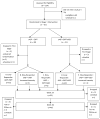Communication interventions for minimally verbal children with autism: a sequential multiple assignment randomized trial
- PMID: 24839882
- PMCID: PMC4030683
- DOI: 10.1016/j.jaac.2014.01.019
Communication interventions for minimally verbal children with autism: a sequential multiple assignment randomized trial
Abstract
Objective: This study tested the effect of beginning treatment with a speech-generating device (SGD) in the context of a blended, adaptive treatment design for improving spontaneous, communicative utterances in school-aged, minimally verbal children with autism.
Method: A total of 61 minimally verbal children with autism, aged 5 to 8 years, were randomized to a blended developmental/behavioral intervention (JASP+EMT) with or without the augmentation of a SGD for 6 months with a 3-month follow-up. The intervention consisted of 2 stages. In stage 1, all children received 2 sessions per week for 3 months. Stage 2 intervention was adapted (by increased sessions or adding the SGD) based on the child's early response. The primary outcome was the total number of spontaneous communicative utterances; secondary measures were the total number of novel words and total comments from a natural language sample.
Results: Primary aim results found improvements in spontaneous communicative utterances, novel words, and comments that all favored the blended behavioral intervention that began by including an SGD (JASP+EMT+SGD) as opposed to spoken words alone (JASP+EMT). Secondary aim results suggest that the adaptive intervention beginning with JASP+EMT+SGD and intensifying JASP+EMT+SGD for children who were slow responders led to better posttreatment outcomes.
Conclusion: Minimally verbal school-aged children can make significant and rapid gains in spoken spontaneous language with a novel, blended intervention that focuses on joint engagement and play skills and incorporates an SGD. Future studies should further explore the tailoring design used in this study to better understand children's response to treatment. Clinical trial registration information-Developmental and Augmented Intervention for Facilitating Expressive Language (CCNIA); http://clinicaltrials.gov/; NCT01013545.
Keywords: SMART design; autism spectrum disorders; communication intervention; minimally verbal; school-aged.
Copyright © 2014 American Academy of Child and Adolescent Psychiatry. Published by Elsevier Inc. All rights reserved.
Figures


References
-
- Rutter M, Greenfeld D, Lockyer L. A five to fifteen year follow-up of infantile psychosis: II. Social and behavioral outcome. Brit J Psychiatry. 1967;113:1183–1189. - PubMed
-
- Pickett E, Pullara O, O’Grady J, Gordon B. Speech acquisition in older nonverbal individuals with autism: A review of features, methods and prognosis. Cog Behav Neurol. 2009;22:1–21. - PubMed
Publication types
MeSH terms
Associated data
Grants and funding
LinkOut - more resources
Full Text Sources
Other Literature Sources
Medical

